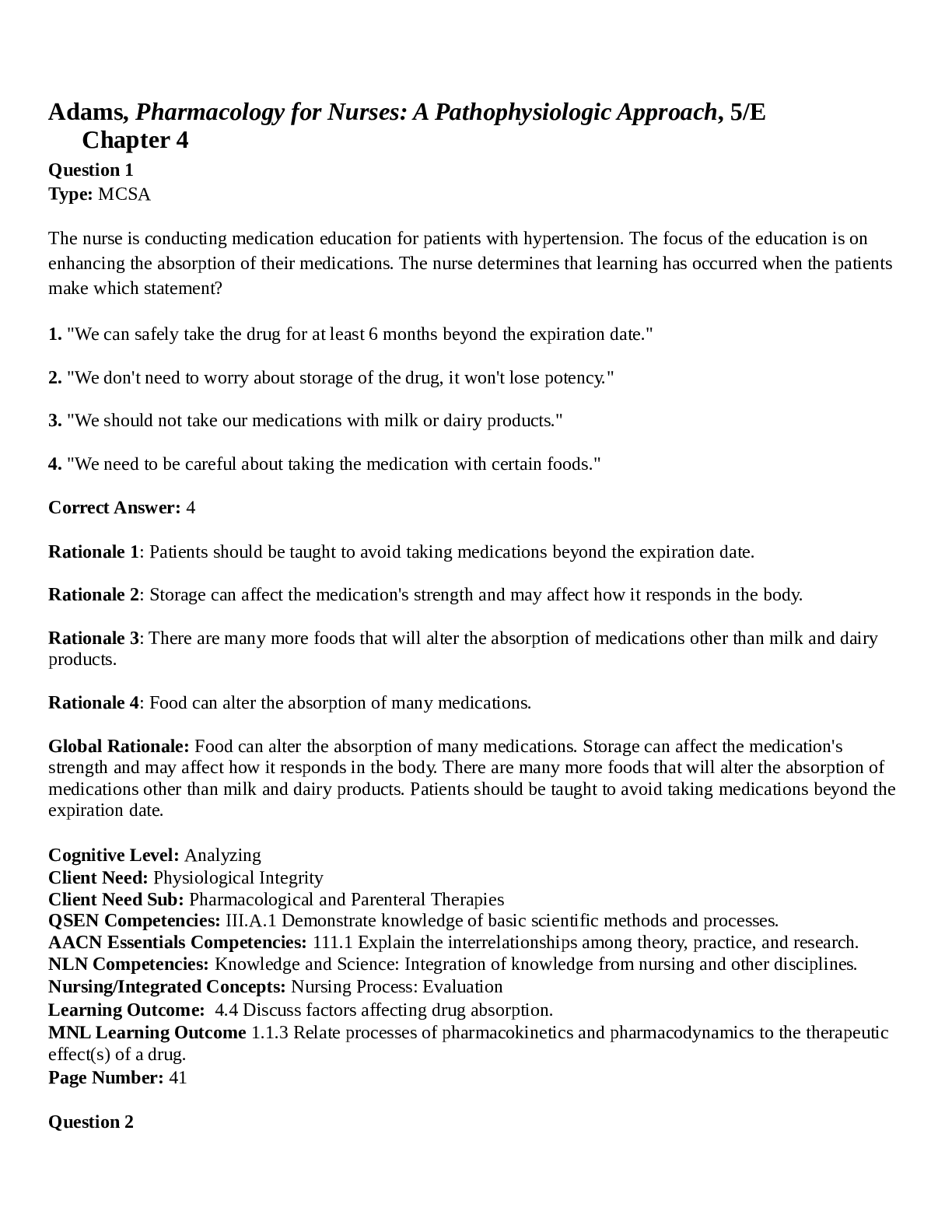*NURSING > EXAM > Adams, Pharmacology for Nurses: A Pathophysiologic Approach, 5/E Chapter 19 Final,100% CORRECT (All)
Adams, Pharmacology for Nurses: A Pathophysiologic Approach, 5/E Chapter 19 Final,100% CORRECT
Document Content and Description Below
Adams, Pharmacology for Nurses: A Pathophysiologic Approach, 5/E Chapter 19 Final Question 1 Type: MCMA The nursing instructor teaches the nursing students about the advantages of local anesthetics,... such as (Xylocaine). What will the best plan of the nursing instructor include? Note: Credit will be given only if all correct choices and no incorrect choices are selected. Standard Text: Select all that apply. 1. Amides have fewer side effects than esters. 2. Amides block potassium entry into the cell. 3. Amides are similar in structure to cocaine. 4. Amides tend to last longer than esters. 5. Amides block calcium entry into the cell. Correct Answer: 1,4 Rationale 1: Amides have largely replaced esters because they produce fewer side effects. Rationale 2: Amides block sodium, not potassium, entry into the cell. Rationale 3: Cocaine is a natural ester, not an amide. Rationale 4: Rationale 5: Amides block sodium, not calcium, entry into the cell. Global Rationale: Amides have largely replaced esters because they produce fewer side effects and generally have a longer duration of action. Amides block sodium, not potassium, entry into the cell. Cocaine is a natural ester, not an amide. Amides block sodium, not calcium, entry into the cell. Cognitive Level: Applying Client Need: Physiological Integrity Client Need Sub: Pharmacological and Parenteral Therapies QSEN Competencies: III.A.1 Demonstrate knowledge of basic scientific methods and processes. AACN Essentials Competencies: III.1 Explain the interrelationships among theory, practice and research. NLN Competencies: Knowledge and Science: Integration of knowledge from nursing and other disciplines. Nursing/Integrated Concepts: Nursing Process: Planning Learning Outcome: 19-2 Describe differences between the two major chemical classes of local anesthetics. MNL Learning Outcome: Page Number: 265 Question 2 Type: MCSA EXAM The patient has entered Stage 3 of general anesthesia, known as surgical anesthesia. What will the of the nurse reveal? 1. Heart rate and breathing become irregular. 2. General sensation is lost, but the patient remains conscious. 3. The medulla region of the brain is paralyzed. 4. Relaxation, stable respiration, and slow eye movements Correct Answer: 4 Rationale 1: Heart rate and breathing become irregular in Stage 2, not Stage 3. Rationale 2: Loss of general sensation while still conscious occurs in Stage 1, not Stage 3. Rationale 3: The medulla region of the brain is paralyzed in Stage 4, not Stage 3. Global Rationale: In surgical anesthesia, skeletal muscles become relaxed, cardiovascular and breathing activities stabilize, and eye movements are slow. Heart rate and breathing become irregular in Stage 2, not Stage 3. The medulla region of the brain is paralyzed in Stage 4, not Stage 3. Loss of general sensation while still conscious occurs in Stage 1, not Stage 3. Cognitive Level: Analyzing Client Need: Physiological Integrity Client Need Sub: Pharmacological and Parenteral Therapies QSEN Competencies: III.A.1 Demonstrate knowledge of basic scientific methods and processes. AACN Essentials Competencies: III.1 Explain the interrelationships among theory, practice and research. NLN Competencies: Knowledge and Science: Integration of knowledge from nursing and other disciplines. Nursing/Integrated Concepts: Nursing Process: Assessment Learning Outcome: 19-6 Identify the four stages of general anesthesia. MNL Learning Outcome: Page Number: 270 Question 3 Type: MCMA 430 with lo 15mins The nurse teaches the patient about the correct use of a topical anesthetic for a skin condition. The nurse determines that learning has occurred when the patient makes which statements? Note: Credit will be given only if all correct choices and no incorrect choices are selected. Standard Text: Select all that apply. 1. "This lotion should only be used on small areas of skin." 2. "I must wear gloves when I apply the lotion." 3. "This lotion works well on cuts too." Th nurse near a gloves if pit for a4. "I must wash my hands before touching my eyes." 5. "It's all right to use a lotion after the expiration date." Correct Answer: 1,4 Pt but It dont put glove for putting their own skin Rationale 1: Injury could result if topical anesthetics are applied to large areas of skin. Rationale 2: The nurse, not the patient, must wear gloves when applying topical anesthetics. Rationale 3: Topical anesthetics should be applied to intact skin only, not on cuts. Rationale 4: Topical anesthetics must be kept away from the eyes unless they are ophthalmic preparations. Rationale 5: Drugs, including lotions, should not be used past the expiration date. Global Rationale: Topical anesthetics must be kept away from the eyes unless they are ophthalmic preparations, and injury could result if topical anesthetics are applied to large areas of skin. Topical anesthetics should be applied to intact skin only, not on cuts. Drugs, including lotions, should not be used past the expiration date. The nurse, not the patient, must wear gloves when applying topical anesthetics. Cognitive Level: Analyzing Client Need: Physiological Integrity Client Need Sub: Pharmacological and Parenteral Therapies QSEN Competencies: III.A.1 Demonstrate knowledge of basic scientific methods and processes. AACN Essentials Competencies: IX.7 Provide appropriate patient teaching that reflects developmental stage, age, culture, spirituality, patient preferences, and health literacy considerations to foster patient engagement in their care. NLN Competencies: Knowledge and Science: Integration of knowledge from nursing and other disciplines. Nursing/Integrated Concepts: Nursing Process: Evaluation Learning Outcome: 19-1 Compare and contrast the five major clinical techniques for administering local anesthetics. MNL Learning Outcome: Page Number: 269 Question 4 Type: MCSA What does the nurse recognize as the most dangerous 1. Hypertension 2. Ventricular tachycardia O3. Malignant hyperthermia high temperature causing 4. Increased intracranial pressure Correct Answer: 3 Rationale 1: Hypotension is more likely to occur than hypertension. Rationale 2: Ventricular tachycardia is serious but can be treated. Rationale 3: deaf Rationale 4: Increased intracranial pressure is not a common adverse effect but can be treated. Global Rationale: Malignant hyperthermia is rare, but it is fatal if not treated immediately. Ventricular tachycardia is serious but can be treated. Increased intracranial pressure is not a common adverse effect but can be treated. Hypotension is more likely to occur than hypertension. Cognitive Level: Analyzing Client Need: Physiological Integrity Client Need Sub: Pharmacological and Parenteral Therapies QSEN Competencies: III.A.1 Demonstrate knowledge of basic scientific methods and processes. AACN Essentials Competencies: III.1 Explain the interrelationships among theory, practice and research. NLN Competencies: Knowledge and Science: Integration of knowledge from nursing and other disciplines. Nursing/Integrated Concepts: Nursing Process: Assessment Learning Outcome: 19-4 Identify the actions of general anesthetics on the central nervous system. MNL Learning Outcome: Page Number: 272 Question 5 Type: MCSA neuritinuscular Blocker p Respiratory paralysis V 1. Spontaneous bleeding O2. Respiratory paralysis 3. Anaphylactic shock 4. Delirium Correct Answer: 2 T uromusculine diaphram Rationale 1: Spontaneous bleeding is not related to this drug. p Rationale 2: Succinylcholine (Anectine) is a neuromuscular blocker that paralyzes muscles, including those of Rationale 3: Allergic reactions, like anaphylactic shock, are uncommon with this drug. Rationale 4: Delirium is not related to this drug. Global Rationale: Succinylcholine (Anectine) is a neuromuscular blocker that paralyzes muscles, including those of respiration. Spontaneous bleeding is not related to this drug. Delirium is not related to this drug. Allergic reactions, like anaphylactic shock, are uncommon with this drug. Cognitive Level: Applying Client Need: Physiological Integrity Client Need Sub: Pharmacological and Parenteral Therapies QSEN Competencies: V.A.4 Delineate general categories of errors and hazards in care. AACN Essentials Competencies: IX.3 Implement holistic, patient-centered care that reflects an understanding of human growth and development, pathophysiology, pharmacology, medical management and nursing management across the health-illness continuum, across lifespan, and in all healthcare settings. NLN Competencies: Knowledge and Science: Integration of knowledge from nursing and other disciplines. Nursing/Integrated Concepts: Nursing Process: Planning Learning Outcome: 19-7 For each of the drug classes listed in Drugs at a Glance, know representative drug examples, and explain their mechanisms of action, primary actions, and important adverse effects. MNL Learning Outcome: amount Page Number: 277 reduces the c Anectine blocker anestheth neuromuscular Question 6 Type: MCSA ofgeneral needed procedures Assess respiratory paralysis A Anectine The student nurse does an operating room rotation and notes that many patients receive succinylcholine (Anectine). The student nurse asks the nursing instructor how the drug works. What is the best response by the nursing instructor? 1. "It causes the patient to rapidly lose consciousness." 2. "It increases cardiac output by raising the heart rate." 3. "It interferes with impulse transmission, resulting in total anesthesia from the pain of surgery." 4. "It reduces the amount of general anesthetic needed for procedures." Correct Answer: 4 Rationale 1: The patient does not lose consciousness and is wide awake. Rationale 2: Heart rate is not increased. Rationale 3: The changes to impulse transmission do not result in pain control or anesthesia. Rationale 4: Succinylcholine (Anectine) does decrease the amount of general anesthetic needed. Global Rationale: Succinylcholine (Anectine) does decrease the amount of general anesthetic needed. The patient does not lose consciousness and is wide awake. Heart rate is not increased. The changes to impulse transmission do not result in pain control or anesthesia. Cognitive Level: Applying Client Need: Physiological Integrity Client Need Sub: Pharmacological and Parenteral Therapies QSEN Competencies: V.A.4 Delineate general categories of errors and hazards in care. AACN Essentials Competencies: IX.3 Implement holistic, patient-centered care that reflects an understanding of human growth and development, pathophysiology, pharmacology, medical management and nursing management across the health-illness continuum, across lifespan, and in all healthcare settings. NLN Competencies: Knowledge and Science: Integration of knowledge from nursing and other disciplines. Nursing/Integrated Concepts: Nursing Process: Implementation Learning Outcome: 19-7 For each of the drug classes listed in Drugs at a Glance, know representative drug examples, and explain their mechanisms of action, primary actions, and important adverse effects. MNL Learning Outcome: Page Number: 277 Question 7 Type: MCSA indefouton the skin r The patient has a serious laceration to the arm. The patient receives a local anesthetic mixed with epinephrine prior to suturing. What does the nurse recognize as the rationale for the epinephrine? 1. Constricted blood vessels will extend the duration of action of the drug. 2. Constricted blood vessels will decrease the amount of pain experienced. 3. Constricted blood vessels will promote relaxation of the patient. 4. Constricted blood vessels will result in decreased bleeding. Correct Answer: 1 Rationale 1: Epinephrine is often added to local anesthetics to constrict blood vessels and extend the duration of Rationale 2: Vasoconstriction does not decrease pain. Rationale 3: Vasoconstriction will not promote relaxation in the patient. Rationale 4: The amount of vasoconstriction will not significantly decrease bleeding. Global Rationale: Epinephrine is often added to local anesthetics to constrict blood vessels and extend the duration of action of the drug. The amount of vasoconstriction will not significantly decrease bleeding. Vasoconstriction does not decrease pain. Vasoconstriction will not promote relaxation in the patient. Cognitive Level: Analyzing Client Need: Physiological Integrity Client Need Sub: Pharmacological and Parenteral Therapies QSEN Competencies: III.A.1 Demonstrate knowledge of basic scientific methods and processes. AACN Essentials Competencies: III.1 Explain the interrelationships among theory, practice, and research. NLN Competencies: Knowledge and Science: Integration of knowledge from nursing and other disciplines. Nursing/Integrated Concepts: Nursing Process: Evaluation Learning Outcome: 19-3 Explain why epinephrine and sodium bicarbonate are sometimes included in local anesthetic cartridges. MNL Learning Outcome: Page Number: 264 Question 8 Type: MCSA Ateriosclerosis inner wall have a fatty plaques to the is most likely to experience an 1. A 15-year-old with diabetes mellitus 2. A 6-year-old with no chronic health problems 3. A 79-year-old with arteriosclerosis 4. A 55-year-old with a serious neck injury Correct Answer: 3 Rationale 1: Adolescents are similar to adults in risk factors associated with inhalation anesthesia; they are not at high risk for an adverse reaction. Rationale 2: Children are more sensitive to inhalation anesthesia than adults, but this 6 year-old child is healthy and so should not be at high risk for an adverse reaction. Rationale 4: Adults are usually considered safe for inhalation anesthesia, and the neck injury is not a contraindication to anesthesia. Global Rationale: Older adults are more sensitive to the effects of inhalation anesthesia, and arteriosclerosis indicates that other organs may not be healthy. Adolescents are similar to adults in risk factors associated with inhalation anesthesia; they are not at high risk for an adverse reaction. Children are more sensitive to inhalation anesthesia than adults, but this 6 year-old child is healthy and so should not be at high risk for an adverse reaction. Adults are usually considered safe for inhalation anesthesia, and the neck injury is not a contraindication to anesthesia. Cognitive Level: Analyzing Client Need: Physiological Integrity Client Need Sub: Pharmacological and Parenteral Therapies QSEN Competencies: I.B.3 Provide patient-centered care with sensitivity and respect for the diversity of human experience. AACN Essentials Competencies: IX.3 Implement holistic, patient-centered care that reflects an understanding of human growth and development, pathophysiology, pharmacology, medical management and nursing management across the health-illness continuum, across lifespan, and in all healthcare settings. NLN Competencies: Knowledge and Science: Integration of knowledge from nursing and other disciplines. Nursing/Integrated Concepts: Nursing Process: Assessment Learning Outcome: 19-9 Use the nursing process to care for patients who are receiving pharmacotherapy with anesthetic agents. MNL Learning Outcome: Page Number: 275 Hyperexcitable Question 9 Type: MCSA Heartrate andbreathingbecomeirregular The patient is in Stage 2 of general anesthesia. What are the priority nursing 1. Assist the anesthesiologist in repositioning the patient. at this time? 2. Complete the surgical scrub. 3. Keep the environment quiet and calm. r 4. Insert the indwelling urinary catheter. Correct Answer: 3 Rationale 1: It is not appropriate to reposition the patient during Stage 2 of anesthesia. Rationale 2: It is not appropriate to complete the surgical scrub during Stage 2 of anesthesia. Rationale 4: It is not appropriate to insert an indwelling urinary catheter during Stage 2 of anesthesia. Global Rationale: The patient is hyperexcitable in Stage 2 of anesthesia so the environment must be kept quiet to minimize stimulation. It is not appropriate to reposition the patient during Stage 2 of anesthesia. It is not appropriate to insert an indwelling urinary catheter during Stage 2 of anesthesia. It is not appropriate to complete the surgical scrub during Stage 2 of anesthesia. Cognitive Level: Analyzing Client Need: Physiological Integrity Client Need Sub: Pharmacological and Parenteral Therapies QSEN Competencies: III.A.1 Demonstrate knowledge of basic scientific methods and processes. AACN Essentials Competencies: III.1 Explain the interrelationships among theory, practice and research. NLN Competencies: Knowledge and Science: Integration of knowledge from nursing and other disciplines. Nursing/Integrated Concepts: Nursing Process: Implementation Learning Outcome: 19-6 Identify the four stages of general anesthesia. MNL Learning Outcome: Page Number: 270 Question 10 Type: MCSA local anesthesia wouldnoteffectthe baby A pregnant woman has a malignant melanoma on her leg and will need surgery. She is concerned about anesthesia. What is the best response by the nurse? 1. "You will probably have an epidural, and this won't harm your baby." 2. "There are newer general anesthetics available that are safe for your baby." 3. "You will most likely have local anesthesia; this will not affect your baby." 4. "Inhalation anesthetics are safe because they remain in your lungs." Correct Answer: 3 Rationale 1: Epidural anesthesia is not indicated in this situation. Rationale 2: There are not any general anesthetics that are considered safe, and this patient will most likely have local anesthesia. Rationale 4: Inhalation anesthesia is not indicated in this situation, and even though it remains primarily in the lungs, it can affect the baby. Global Rationale: Local anesthetics are most commonly used to remove lesions. They stay in the treatment area and do not impact the baby. There are not any general anesthetics that are considered safe, and this patient will most likely have local anesthesia. Epidural anesthesia is not indicated in this situation. Inhalation anesthesia is not indicated in this situation, and even though it remains primarily in the lungs, it can affect the baby. Cognitive Level: Analyzing Client Need: Physiological Integrity Client Need Sub: Pharmacological and Parenteral Therapies QSEN Competencies: V.A.4 Delineate general categories of errors and hazards in care. AACN Essentials Competencies: IX.3 Implement holistic, patient-centered care that reflects an understanding of human growth and development, pathophysiology, pharmacology, medical management and nursing management across the health-illness continuum, across lifespan, and in all healthcare settings. NLN Competencies: Knowledge and Science: Integration of knowledge from nursing and other disciplines. Nursing/Integrated Concepts: Nursing Process: Implementation Learning Outcome: 19-7 For each of the drug classes listed in Drugs at a Glance, know representative drug examples, and explain their mechanisms of action, primary actions, and important adverse effects. MNL Learning Outcome: Page Number: 267 we are going to use an w first to make pt Question 11 Type: MCSA to lose their consciousness then inhaled the agent to maintain anesthesia The patient is scheduled for a surgical procedure. The nurse plans to teach the patient about anesthesia. Which statement would be included in the best plan of the nurse? 1. "An inhaled agent needs to be followed by an intravenous (IV) agent if it is ineffective." 2. "An inhaled agent is used to induce sleep, followed by an intravenous (IV) agent for relaxation." 3. "An intravenous (IV) agent to induce sleep is usually all that is required." 4. "An intravenous (IV) agent will be used first to induce sleep; then, an inhaled agent will be used." Correct Answer: 4 Rationale 1: Inhaled agents are given after intravenous (IV) agents to maintain anesthesia, not if the intravenous (IV) agent is ineffective. Rationale 2: An intravenous (IV) agent, not an inhaled agent, is used to induce sleep. Rationale 3: Patients require more anesthesia than just intravenous (IV) anesthesia. Global Rationale: Intravenous agents are usually administered first because they act within a few seconds. After the patient loses consciousness, inhaled agents are used to maintain the anesthesia. Patients require more anesthesia than just intravenous (IV) anesthesia. An intravenous (IV) agent, not an inhaled agent, is used to induce sleep. Inhaled agents are given after intravenous (IV) agents to maintain anesthesia, not if the intravenous (IV) agent is ineffective. Cognitive Level: Applying Client Need: Physiological Integrity Client Need Sub: Pharmacological and Parenteral Therapies QSEN Competencies: III.A.1 Demonstrate knowledge of basic scientific methods and processes. AACN Essentials Competencies: III.1 Explain the interrelationships among theory, practice and research. NLN Competencies: Knowledge and Science: Integration of knowledge from nursing and other disciplines. Nursing/Integrated Concepts: Nursing Process: Implementation Learning Outcome: 19-5 Compare and contrast the two primary ways that general anesthesia may be induced. MNL Learning Outcome: Page Number: 270 for the child who afrid of the needle we use Question 12 Type: MCSA local anesthetic cream to Rob on theirskin so the child will not feel any needle The 2-year-old child comes to the emergency department with a laceration to the lower leg. The physician plans to use a local anesthetic, but the child screams at the sight of the needle. What is the best action by the nurse? 1. Wrap the child in a blanket to restrain him and ensure safety during suturing. 3. Administer a small dose of a medication such as lorazepam (Ativan). 4. Ask the parents to leave the room so the child will quiet down. Correct Answer: 2 Rationale 1: Restraining the child will terrify him and is not indicated at this time. Rationale 2: The child will be more cooperative if there isn't any pain from an injection. Rationale 3: There isn't any indication to administer lorazepam (Ativan). Rationale 4: The presence of parents usually decreases a child's anxiety and increases cooperation. Global Rationale: The child will be more cooperative if there isn't any pain from an injection. There isn't any indication to administer lorazepam (Ativan). Restraining the child will terrify him and is not indicated at this time. The presence of parents usually decreases a child's anxiety and increases cooperation. Cognitive Level: Analyzing Client Need: Physiological Integrity Client Need Sub: Pharmacological and Parenteral Therapies QSEN Competencies: III.A.1 Demonstrate knowledge of basic scientific methods and processes. AACN Essentials Competencies: III.1 Explain the interrelationships among theory, practice and research. NLN Competencies: Knowledge and Science: Integration of knowledge from nursing and other disciplines. Nursing/Integrated Concepts: Nursing Process: Implementation Learning Outcome: 19-8 Categorize drugs used before, during, and after anesthesia based on their classification and drug action. MNL Learning Outcome: Page Number: 267 Question 13 r Type: MCSA The patient has gastroesophageal reflux disease and receives lidocaine viscous prior to an endoscopy. What will be the nurse’s priority assessment immediately after the procedure? O1. Assess for a return of the gag reflex. v 2. Assess for nausea and vomiting. 3. Assess for any damage to the teeth or gums. 4. Assess for a headache. Correct Answer: 1 Rationale 1: The gag reflex must be assessed before giving the patient anything to eat or drink. Rationale 2: Nausea and vomiting are not common after an endoscopy. Rationale 3: Damage to the teeth or gums is rare following an endoscopy. Rationale 4: Headaches are not common after an endoscopy. Global Rationale: The gag reflex must be assessed before giving the patient anything to eat or drink. Damage to the teeth or gums is rare following an endoscopy. Nausea and vomiting are not common after an endoscopy. Headaches are not common after an endoscopy. Cognitive Level: Analyzing Client Need: Physiological Integrity Client Need Sub: Pharmacological and Parenteral Therapies QSEN Competencies: I.B.3 Provide patient-centered care with sensitivity and respect for the diversity of human experience. AACN Essentials Competencies: IX.3 Implement holistic, patient-centered care that reflects an understanding of human growth and development, pathophysiology, pharmacology, medical management and nursing management across the health-illness continuum, across lifespan, and in all healthcare settings. NLN Competencies: Knowledge and Science: Integration of knowledge from nursing and other disciplines. Nursing/Integrated Concepts: Nursing Process: Assessment Learning Outcome: 19-9 Use the nursing process to care for patients who are receiving pharmacotherapy with anesthetic agents. MNL Learning Outcome: Page Number: 269 Question 14 Type: MCSA Which clinical technique for administering anesthesia is common for pregnant women during labor and delivery? 1. Nerve block 2. Topical 3. Infiltration x It is not a of anesthesia Correct Answer: 4 Rationale 1: Nerve block is not a form of anesthesia commonly used for women during labor and delivery. Rationale 2: Topical is not a form of anesthesia commonly used for women during labor and delivery. Rationale 3: Anesthesia via the epidural route is the most common for women during labor and delivery. Infiltration is not a form of anesthesia commonly used for women during labor and delivery. Rationale 4: Anesthesia via the epidural route is the most common for women during labor and delivery. Global Rationale: Anesthesia via the epidural route is the most common for women during labor and delivery. Cognitive Level: Remembering Client Need: Physiological Integrity Client Need Sub: Pharmacological and Parenteral Therapies QSEN Competencies: III.A.1 Demonstrate knowledge of basic scientific methods and processes. AACN Essentials Competencies: III.1 Explain the interrelationships among theory, practice and research. NLN Competencies: Knowledge and Science: Integration of knowledge from nursing and other disciplines. Nursing/Integrated Concepts: Nursing Process: Planning Learning Outcome: 19-1 Compare and contrast the five major clinical techniques for administering local anesthetics. MNL Learning Outcome: Page Number: 264 Question 15 Type: MCSA 1. enhancing the influx of calcium into the cell. 2. occupying potassium receptors. 3. increasing nerve impulse transmission. Rationale 1: Enhancing calcium into the cell is not the mechanism of action for local anesthetics. Rationale 2: Occupying potassium receptors is not the mechanism of action for local anesthetics. Rationale 3: Local anesthetics block sodium channels, resulting in diminished motor and sensory impulse transmission. Increasing nerve impulse transmission is not the mechanism of action for local anesthetics. Global Rationale: Local anesthetics block sodium channels, resulting in diminished motor and sensory impulse transmission. Enhancing calcium into the cell, occupying potassium receptors, and increasing nerve impulse transmission are not the mechanism of action for local anesthetics. Cognitive Level: Remembering Client Need: Physiological Integrity Client Need Sub: Pharmacological and Parenteral Therapies QSEN Competencies: III.A.1 Demonstrate knowledge of basic scientific methods and processes. AACN Essentials Competencies: III.1 Explain the interrelationships among theory, practice and research. NLN Competencies: Knowledge and Science: Integration of knowledge from nursing and other disciplines. Nursing/Integrated Concepts: Nursing Process: Planning Learning Outcome: 19-8 Categorize drugs used before, during, and after anesthesia based on their classification and drug action. MNL Learning Outcome: Page Number: 264 Rationale 1: Tetracaine (Pontocaine) is classified as an ester, which has more side effects than an amide. Rationale 2: Procaine (Novocain) is classified as an ester, which has more side effects than an amide. Rationale 3: Lidocaine is classified as an amide, and amides produce fewer side effects than do esters. Rationale 4: Chloroprocaine (Nesacaine) is classified as an ester, which has more side effects than an amide. Global Rationale: All except lidocaine are classified as esters. Lidocaine is classified as an amide, and amides produce fewer side effects than do esters. Cognitive Level: Understanding Client Need: Physiological Integrity Client Need Sub: Pharmacological and Parenteral Therapies QSEN Competencies: III.A.1 Demonstrate knowledge of basic scientific methods and processes. AACN Essentials Competencies: III.1 Explain the interrelationships among theory, practice and research. NLN Competencies: Knowledge and Science: Integration of knowledge from nursing and other disciplines. Nursing/Integrated Concepts: Nursing Process: Planning Learning Outcome: 19-2 Describe differences between the two major chemical classes of local anesthetics. MNL Learning Outcome: Page Number: 265 Question 17 Type: MCSA A patient with severe cardiac disorder requires closure of a deep laceration. The nurse would plan for analgesia? 1. Plain epinephrine 2. Laceration repair without anesthesia not used for cardiac pet Correct Answer: 4 Rationale 1: Epinephrine is not an analgesic. Rationale 2: Laceration repair is painful and should not be done without anesthesia. Rationale 3: Topical application would not be sufficient analgesia for repair of a deep laceration. Global Rationale:. Epinephrine extends the time anesthesia is present because it causes vasoconstriction which slows the rate of distribution. It is not necessary for effective anesthesia and is contraindicated in those with severe cardiovascular disorders. Epinephrine is not an analgesic. Laceration repair is painful and should not be done without anesthesia. Topical application would not be sufficient analgesia for repair of a deep laceration. Cognitive Level: Analyzing Client Need: Physiological Integrity Client Need Sub: Pharmacological and Parenteral Therapies QSEN Competencies: III.A.1 Demonstrate knowledge of basic scientific methods and processes. AACN Essentials Competencies: III.1 Explain the interrelationships among theory, practice, and research. NLN Competencies: Knowledge and Science: Integration of knowledge from nursing and other disciplines. Nursing/Integrated Concepts: Nursing Process: Planning Learning Outcome: 19-3 Explain why epinephrine and sodium bicarbonate are sometimes included in local anesthetic cartridges. MNL Learning Outcome: Page Number: 266 Question 18 Type: MCSA 1. A sleeping state that can be awakened easily 2. An unconscious state, without analgesia O3. A total loss of body movements 7 Anesthesiacon 4. A conscious but sleepy state of being Correct Answer: 3 Rationale 1: Rationale 2: Rationale 3: Rationale 4: General anesthesia involves loss of consciousness. Global Rationale: General anesthesia involves total analgesia and loss of consciousness, memory, and body movements. Cognitive Level: Remembering Client Need: Physiological Integrity Client Need Sub: Pharmacological and Parenteral Therapies QSEN Competencies: III.A.1 Demonstrate knowledge of basic scientific methods and processes. AACN Essentials Competencies: III.1 Explain the interrelationships among theory, practice and research. NLN Competencies: Knowledge and Science: Integration of knowledge from nursing and other disciplines. Nursing/Integrated Concepts: Nursing Process: Assessment Learning Outcome: 19-4 Identify the actions of general anesthetics on the central nervous system. MNL Learning Outcome: Page Number: 266 Question 19 Type: MCSA Which statement correctly identifies the initial use for an IV in a patient undergoing a lengthy abdominal surgery that requires general anesthesia? 1. To administer agents that will produce rapid unconsciousness 2. To administer reversal agents or other medications used to treat the adverse effects associated with general anesthesia 3. To administer large amounts of colloid solutions following surgical blood loss this is Correct Answer: 1 Rationale 1: IV Rationale 2: The IV may be used to treat adverse effects but this is not an initial use. Rationale 3: The IV may be used to administer replacement fluids, but this is not an initial use. Rationale 4: Volatile liquids are inhaled gases. Global Rationale: IV lines are started prior to surgical procedures requiring general anesthesia to administer agents that will cause rapid loss of consciousness. The IV also may be used to treat adverse effects and administer replacement fluids, but these would not be initial uses. Volatile liquids are inhaled gases. Cognitive Level: Understanding Client Need: Physiological Integrity Client Need Sub: Pharmacological and Parenteral Therapies QSEN Competencies: III.A.1 Demonstrate knowledge of basic scientific methods and processes. AACN Essentials Competencies: III.1 Explain the interrelationships among theory, practice and research. NLN Competencies: Knowledge and Science: Integration of knowledge from nursing and other disciplines. Nursing/Integrated Concepts: Nursing Process: Implementation Learning Outcome: 19-5 Compare and contrast the two primary ways that general anesthesia may be induced. MNL Learning Outcome: Page Number: 270 Question 20 Type: MCSA sthesia desirable for surgery? ous breathing. 4. The patient loses sensation, but is awake. Correct Answer: 3 Rationale 4: Surgical anesthesia includes loss of consciousness. Global Rationale: Surgical anesthesia occurs at Stage 3, where the patient is not conscious and is relaxed, eye movement has slowed, and vital signs have stabilized. It includes loss of voluntary movement and loss of consciousness. Stage 4 includes paralysis of the medulla with loss of respiratory drive. Cognitive Level: Applying Client Need: Physiological Integrity Client Need Sub: Pharmacological and Parenteral Therapies QSEN Competencies: III.A.1 Demonstrate knowledge of basic scientific methods and processes. AACN Essentials Competencies: III.1 Explain the interrelationships among theory, practice and research. NLN Competencies: Knowledge and Science: Integration of knowledge from nursing and other disciplines. Nursing/Integrated Concepts: Nursing Process: Assessment Learning Outcome: 19-6 Identify the four stages of general anesthesia. MNL Learning Outcome: Page Number: 270 Question 21 Type: MCSA A patient undergoing surgery is receiving general anesthesia as well as a neuromuscular blocking agent. Which statement best indicates the primary reason for the neuromuscular blocking agent? 1. To potentiate analgesic effects 2. To prevent adverse effects associated with inhaled gases 3. To cause total skeletal muscle relaxation 4. To induce unconsciousness Correct Answer: 3 Rationale 1: They do allow for lower amounts of anesthetics to be used, which can reduce adverse effects, but this is not the primary reason. Rationale 2: Neuromuscular blocking agents do not potentiate analgesia. Rationale 3: The primary purpose of administering neuromuscular blocking agents is to cause total skeletal Rationale 4: Neuromuscular blocking agents do not induce unconsciousness. Global Rationale: The primary purpose of administering neuromuscular blocking agents is to cause total skeletal muscle relaxation. Neuromuscular blocking agents do not potentiate analgesia or induce unconsciousness. They do allow for lower amounts of anesthetics to be used, which can reduce adverse effects, but this is not the primary reason. Cognitive Level: Applying Client Need: Physiological Integrity Client Need Sub: Pharmacological and Parenteral Therapies QSEN Competencies: III.A.1 Demonstrate knowledge of basic scientific methods and processes. AACN Essentials Competencies: III.1 Explain the interrelationships among theory, practice and research. NLN Competencies: Knowledge and Science: Integration of knowledge from nursing and other disciplines. Nursing/Integrated Concepts: Nursing Process: Implementation Learning Outcome: 19-8 Categorize drugs used before, during, and after anesthesia based on their classification and drug action. MNL Learning Outcome: produceeffect Page Number: 276 Question 22 Type: MCMA benzodiazepine C b doin Reduce anxietyandstress produce Cns depression 1 muscle Irelan Midazolam (Versed) may be administered as part of surgical anesthesia. This drug is recognized as effects? mm Note: Credit will be given only if all correct choices and no incorrect choices are selected. Standard Text: Select all that apply. 1. Producing effects consistent with those observed in administering other benzodiazepines 2. Reducing anxiety and stress associated with surgery 3. Producing central nervous system depression and skeletal muscle relaxation 4. Maintaining stable cardiac and respiratory activity 5. Preventing cardiac dysrhythmias Correct Answer: 1,2,3 Rationale 2: Midazolam (Versed) reduces anxiety and stress associated with surgery. Rationale 3: Midazolam (Versed) produces central nervous system depression and skeletal muscle relaxation. Rationale 4: Midazolam (Versed) is not associated with maintaining stable cardiac and respiratory activity. Rationale 5: Midazolam (Versed) does not prevent cardiac dysrhythmias. Global Rationale: Midazolam (Versed) can produce serious cardiovascular side effects, including hypotension, tachycardia, and cardiovascular collapse. Midazolam (Versed) can produce laryngospasm. Midazolam (Versed) reduces anxiety and stress associated with surgery and produces central nervous system depression and skeletal muscle relaxation. It is not associated with maintaining stable cardiac and respiratory activity and does not prevent cardiac dysrhythmias. Cognitive Level: Applying Client Need: Physiological Integrity Client Need Sub: Pharmacological and Parenteral Therapies QSEN Competencies: III.A.1 Demonstrate knowledge of basic scientific methods and processes. AACN Essentials Competencies: III.1 Explain the interrelationships among theory, practice and research. NLN Competencies: Knowledge and Science: Integration of knowledge from nursing and other disciplines. Nursing/Integrated Concepts: Nursing Process: Implementation Learning Outcome: 19-8 Categorize drugs used before, during, and after anesthesia based on their classification and drug action. MNL Learning Outcome: Page Number: 276 Question 23 Type: MCMA BeBalanced anesthesia Produce general anesthesia O Balanced anesthesia is the use of a combination of medications to produce general anesthesia. Which drugs may be used in combination? Note: Credit will be given only if all correct choices and no incorrect choices are selected. Standard Text: Select all that apply. 1. Benzodiazepines CNS depression 2. Neuromuscular blockers 03. Inhaled anesthetics 4. Proton-pump inhibitors O5. Intravenous anesthetics Correct Answer: 1,2,3,5 Rationale 1: muscle. Rationale 3: Inhaled agents are used to maintain an anesthetized state. Rationale 4: Proton-pump inhibitors are not used in balanced anesthesia. Rationale 5: Intravenous anesthetics relax muscles, diminish pain, and produce sleep. Global Rationale: Benzodiazepines reduce anxiety, produce central nervous system depression, and relax skeletal muscle. Neuromuscular blockers provide skeletal muscle relaxation, which is an important component of general anesthesia. Inhaled agents are used to maintain an anesthetized state. Intravenous anesthetics relax muscles, diminish pain, and produce sleep. Proton-pump inhibitors are not used in balanced anesthesia. Cognitive Level: Analyzing Client Need: Physiological Integrity Client Need Sub: Pharmacological and Parenteral Therapies QSEN Competencies: III.A.1 Demonstrate knowledge of basic scientific methods and processes. AACN Essentials Competencies: III.1 Explain the interrelationships among theory, practice and research. NLN Competencies: Knowledge and Science: Integration of knowledge from nursing and other disciplines. Nursing/Integrated Concepts: Nursing Process: Implementation Learning Outcome: 19-8 Categorize drugs used before, during, and after anesthesia based on their classification and drug action. MNL Learning Outcome: Page Number: 270 Question 24 Type: MCMA Note: Credit will be given only if all correct choices and no incorrect choices are selected. 4. To reduce the risk of a postoperative ileus Correct Answer: 1,3,5 Rationale 1: Benzodiazepines or short-acting barbiturates are used to reduce anxiety and facilitate sedation. Rationale 2: Preoperative adjuncts are not associated with a faster recovery. Rationale 3: Preoperative adjunct medications such as histamine-2 receptor agonists or anticholinergics are used Rationale 4: Preoperative adjuncts are not associated with a reduced risk of a postoperative ileus. Rationale 5: Preoperative adjuncts help to reduce pain that will be felt after surgery. Global Rationale: Benzodiazepines or short-acting barbiturates are used to reduce anxiety and facilitate sedation. Preoperative adjunct medications such as histamine-2 receptor agonists or anticholinergics are used to reduce the risk of aspiration pneumonia. Preoperative adjuncts help to reduce pain that will be felt after surgery. Preoperative adjuncts are not associated with a faster recovery. Preoperative adjuncts are not associated with a reduced risk of a postoperative ileus. Cognitive Level: Analyzing Client Need: Physiological Integrity Client Need Sub: Pharmacological and Parenteral Therapies QSEN Competencies: III.A.1 Demonstrate knowledge of basic scientific methods and processes. AACN Essentials Competencies: III.1 Explain the interrelationships among theory, practice and research. NLN Competencies: Knowledge and Science: Integration of knowledge from nursing and other disciplines. Nursing/Integrated Concepts: Nursing Process: Implementation Learning Outcome: 19-8 Categorize drugs used before, during, and after anesthesia based on their classification and drug action. MNL Learning Outcome: Page Number: 276 Question 25 Type: Hot Spot The nurse explaining epidural anesthesia to a patient would indicate which area as the placement for this type of anesthesia? 1. A 2. B 3. C O4. D Answer: 4 Rationale: An epidural is administered “above the dura.” Cognitive Level: Applying Client Need: Physiological Integrity Client Need Sub: Pharmacological and Parenteral Therapies QSEN Competencies: III.A.1 Demonstrate knowledge of basic scientific methods and processes. AACN Essentials Competencies: IX.7 Provide appropriate patient teaching that reflects developmental stage, age, culture, spirituality, patient preferences, and health literacy considerations to foster patient engagement in their care. NLN Competencies: Knowledge and Science: Integration of knowledge from nursing and other disciplines. Nursing/Integrated Concepts: Nursing Process: Implementation Learning Outcome: 19-1 Compare and contrast the five major clinical techniques for administering local anesthetics. MNL Learning Outcome: Page Number: 263 Question 26 Type: MCMA nowh U d cardiac disease no epinephrine A patient who has history of severe arteriosclerosis has sustained a laceration on the forearm that will be repaired in the emergency department. The nurse would plan to obtain a local anesthetic with which properties? Note: Credit will be given only if all correct choices and no incorrec2t choices are selected. Standard Text: Select all that apply. 1. With no epinephrine 2. With sodium bicarbonate 3. Without lidocaine 4. With a volatile liquid g help to retard bacterial growth Correct Answer: 1,2 Rationale 1: Local anesthetics with epinephrine are not typically used for patients with cardiac diseases. Rationale 2: Sodium bicarbonate is often used to retard bacterial growth. Rationale 3: There is no reason to avoid lidocaine in this patient. Rationale 4: Volatile liquids are used for inhalation anesthesia. Rationale 5: Proparacaine (Alcaine) is used for ocular procedures. Global Rationale: Local anesthetics with epinephrine are not typically used for patients with cardiac diseases. Sodium bicarbonate is often used to retard bacterial growth. There is no reason to avoid lidocaine in this patient. Volatile liquids are used for inhalation anesthesia. Proparacaine (Alcaine) is used for ocular procedures. Cognitive Level: Analyzing Client Need: Physiological Integrity Client Need Sub: Pharmacological and Parenteral Therapies QSEN Competencies: III.A.1 Demonstrate knowledge of basic scientific methods and processes. AACN Essentials Competencies: III.1 Explain the interrelationships among theory, practice, and research. NLN Competencies: Knowledge and Science: Integration of knowledge from nursing and other disciplines. Nursing/Integrated Concepts: Nursing Process: Planning Learning Outcome: 19-3 Explain why epinephrine and sodium bicarbonate are sometimes included in local anesthetic cartridges. MNL Learning Outcome: Page Number: 265 Question 27 Type: MCMA A novice nurse says, "We want to keep our patients in Stage 4 anesthesia during their surgery." How should the supervising nurse interpret this statement? Note: Credit will be given only if all correct choices and no incorrect choices are selected. Standard Text: Select all that apply. O1. The novice nurse has made an error in this statement. O2. Stage 4 anesthesia is avoided. T 3. This is a good description of the goal of anesthesia. 4. The novice nurse should have said Stage 3 anesthesia. 5. A more accurate statement would be that the patient is maintained in anxiolysis anesthesia. Correct Answer: 1,2,4 Rationale 1: Stage 4 is not the goal for anesthesia. Rationale 2: In Stage 4, the medulla is paralyzed and breathing and circulation could stop. This stage is avoided. Rationale 3: This is not the goal of anesthesia. Rationale 5: Anxiolysis is a term used to describe minimal sedation, not general anesthesia. Global Rationale: Stage 4 is not the goal for anesthesia. In Stage 4, the medulla is paralyzed and breathing and circulation could stop. This stage is avoided. The goal of anesthesia is rapid induction through Stages 1 and 2 with the patient remaining in Stage 3 until the end of the procedure. Anxiolysis is a term used to describe minimal sedation, not general anesthesia. Cognitive Level: Analyzing Client Need: Physiological Integrity Client Need Sub: Pharmacological and Parenteral Therapies QSEN Competencies: III.A.1 Demonstrate knowledge of basic scientific methods and processes. AACN Essentials Competencies: III.1 Explain the interrelationships among theory, practice and research. NLN Competencies: Knowledge and Science: Integration of knowledge from nursing and other disciplines. Nursing/Integrated Concepts: Nursing Process: Evaluation Learning Outcome: 19-6 Identify the four stages of general anesthesia. MNL Learning Outcome: Page Number: 270 Question 28 Type: MCMA Standard Text: Select all that apply. 1. Laceration to the ch0eek O2. Laceration to the earlobe ok to use epinephrin 3. Laceration to the end of the nose 4. Laceration on the top of the foot G5O. Laceration on the fingertip Correct Answer: 2,3,5 ok to use the epinephrine Rationale 1: There is no reason to avoid epinephrine when repairing a laceration to the cheek. Rationale 2: Epinephrine should not be used in repair of areas with decreased blood flow, such as the earlobe. Rationale 3: Epinephrine should not be used in repair of areas with decreased blood flow, such as the end of the Rationale 4: There is no reason to avoid epinephrine when repairing a laceration to the top of the foot. Rationale 5: Epinephrine should not be used in repair of areas with decreased blood flow, such as the fingertip. Global Rationale: Epinephrine should not be used in repair of areas with decreased blood flow, such as the earlobe, end of the nose, or fingertips. There is no reason to avoid epinephrine when repairing a laceration to the cheek or top of the foot. Cognitive Level: Analyzing Client Need: Physiological Integrity Client Need Sub: Pharmacological and Parenteral Therapies QSEN Competencies: I.B.3 Provide patient-centered care with sensitivity and respect for the diversity of human experience. AACN Essentials Competencies: IX.3 Implement holistic, patient-centered care that reflects an understanding of human growth and development, pathophysiology, pharmacology, medical management and nursing management across the health-illness continuum, across lifespan, and in all healthcare settings. NLN Competencies: Knowledge and Science: Integration of knowledge from nursing and other disciplines. Nursing/Integrated Concepts: Nursing Process: Assessment Learning Outcome: 19-9 Use the nursing process to care for patients who are receiving pharmacotherapy with anesthetic agents. MNL Learning Outcome: Page Number: 269 Question 29 Type: MCMA p Respiratory depression A patient has inadvertently received two doses of propofol (Diprivan) within 2 minutes of one another. What nursing actions are indicated? f I t Note: Credit will be given only if all correct choices and no incorrect choices are selected. Standard Text: Select all that apply. respiratory depression 2. Monitor the patient closely for development of an allergic skin reaction. 4. Have serum calcium levels drawn immediately. 5. Administer a benzodiazepine. Correct Answer: 1,3 Rationale 1: One of the treatment recommendations for overdose is increasing intravenous fluid rate. Rationale 2: An allergic skin reaction is not likely and is not a priority. Rationale 3: Rationale 4: There is no reason to have an immediate calcium level drawn. Rationale 5: Administering a benzodiazepine would complicate the patient’s care. Global Rationale: One of the treatment recommendations for overdose is increasing intravenous fluid rate. Propofol (Diprivan) causes respiratory depression. Close monitoring is indicated. An allergic skin reaction is not likely and is not a priority. . There is no reason to have an immediate calcium level drawn. Administering a benzodiazepine would complicate the patient’s care. Cognitive Level: Analyzing Client Need: Physiological Integrity Client Need Sub: Pharmacological and Parenteral Therapies QSEN Competencies: I.B.3 Provide patient-centered care with sensitivity and respect for the diversity of human experience. AACN Essentials Competencies: IX.3 Implement holistic, patient-centered care that reflects an understanding of human growth and development, pathophysiology, pharmacology, medical management and nursing management across the health-illness continuum, across lifespan, and in all healthcare settings. NLN Competencies: Knowledge and Science: Integration of knowledge from nursing and other disciplines. Nursing/Integrated Concepts: Nursing Process: Assessment Learning Outcome: 19-9 Use the nursing process to care for patients who are receiving pharmacotherapy with anesthetic agents. MNL Learning Outcome: Page Number: 271 Question 30 Type: MCMA Anelanesthesia A patient is scheduled for an operative procedure in which isoflurane (Forane) will be used as the anesthetic agent. The nurse would immediately collaborate with the anesthesiologist if the patient makes which statements? Note: Credit will be given only if all correct choices and no incorrect choices are selected. Standard Text: Select all that apply. 1. “I stopped taking my vitamin C supplement last week because it upset my stomach.” 2. “I have been so depressed about having this surgery. I don’t think my St. John’s wort is helping at all.” 3. “I have not eaten anything since before my CT scan yesterday.” 4. “My brother ran a high fever and had seizures after his surgery.” 5. “My last dose of levodopa was yesterday.” Correct Answer: 2,4 Rationale 1: There is no contraindication between vitamin C therapy and use of isoflurane (Forane). Rationale 5: Levodopa should be discontinued 6 to8 hours before isoflurane (Forane) administration. Global Rationale: St. John’s wort should be discontinues 2 to 3 weeks prior to administration of isoflurane (Forane) due to possible risk of hypotension. High fever and seizures might indicate that the brother had malignant hyperthermia. If so, the patient may have a genetic tendency. Additional investigation should be done. There is no contraindication between vitamin C therapy and use of isoflurane (Forane). Being NPO for surgery is a standard treatment. Levodopa should be discontinued 6 to8 hours before isoflurane (Forane) administration. Cognitive Level: Analyzing Client Need: Physiological Integrity Client Need Sub: Pharmacological and Parenteral Therapies QSEN Competencies: I.B.3 Provide patient-centered care with sensitivity and respect for the diversity of human experience. AACN Essentials Competencies: IX.3 Implement holistic, patient-centered care that reflects an understanding of human growth and development, pathophysiology, pharmacology, medical management and nursing management across the health-illness continuum, across lifespan, and in all healthcare settings. NLN Competencies: Knowledge and Science: Integration of knowledge from nursing and other disciplines. Nursing/Integrated Concepts: Nursing Process: Assessment Learning Outcome: 19-9 Use the nursing process to care for patients who are receiving pharmacotherapy with anesthetic agents. MNL Learning Outcome: Page Number: 273 [Show More]
Last updated: 1 year ago
Preview 1 out of 35 pages

Reviews( 0 )
Document information
Connected school, study & course
About the document
Uploaded On
Feb 12, 2021
Number of pages
35
Written in
Additional information
This document has been written for:
Uploaded
Feb 12, 2021
Downloads
0
Views
64




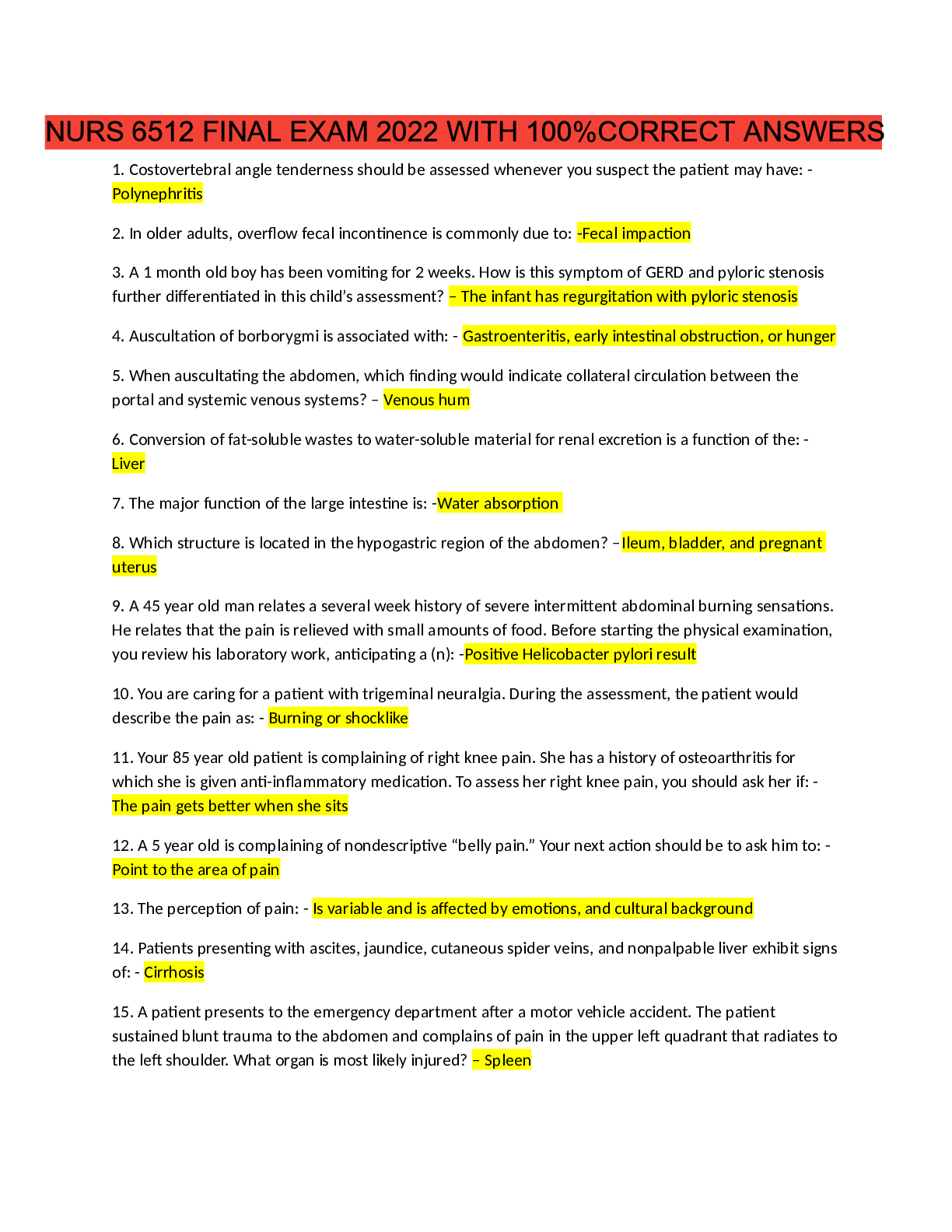

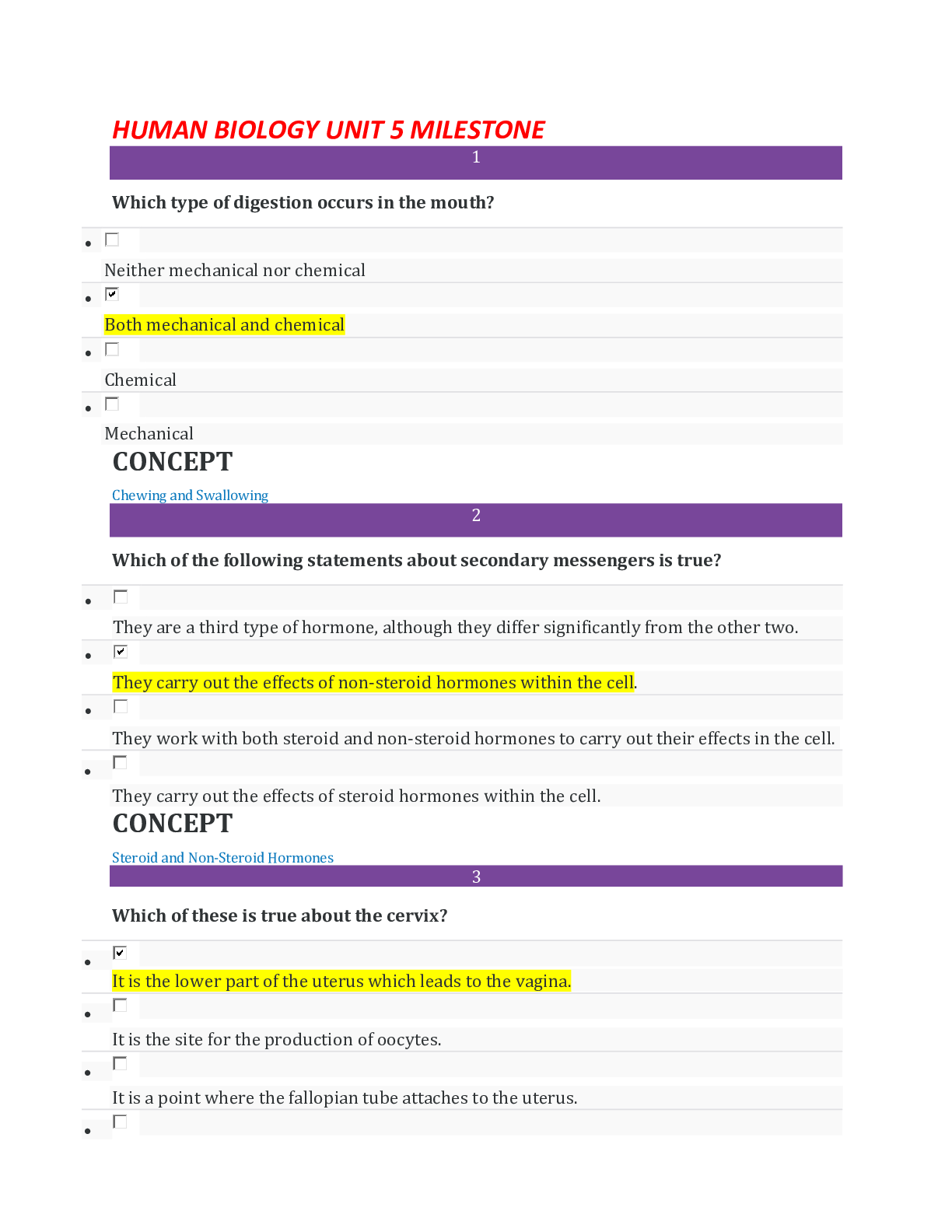










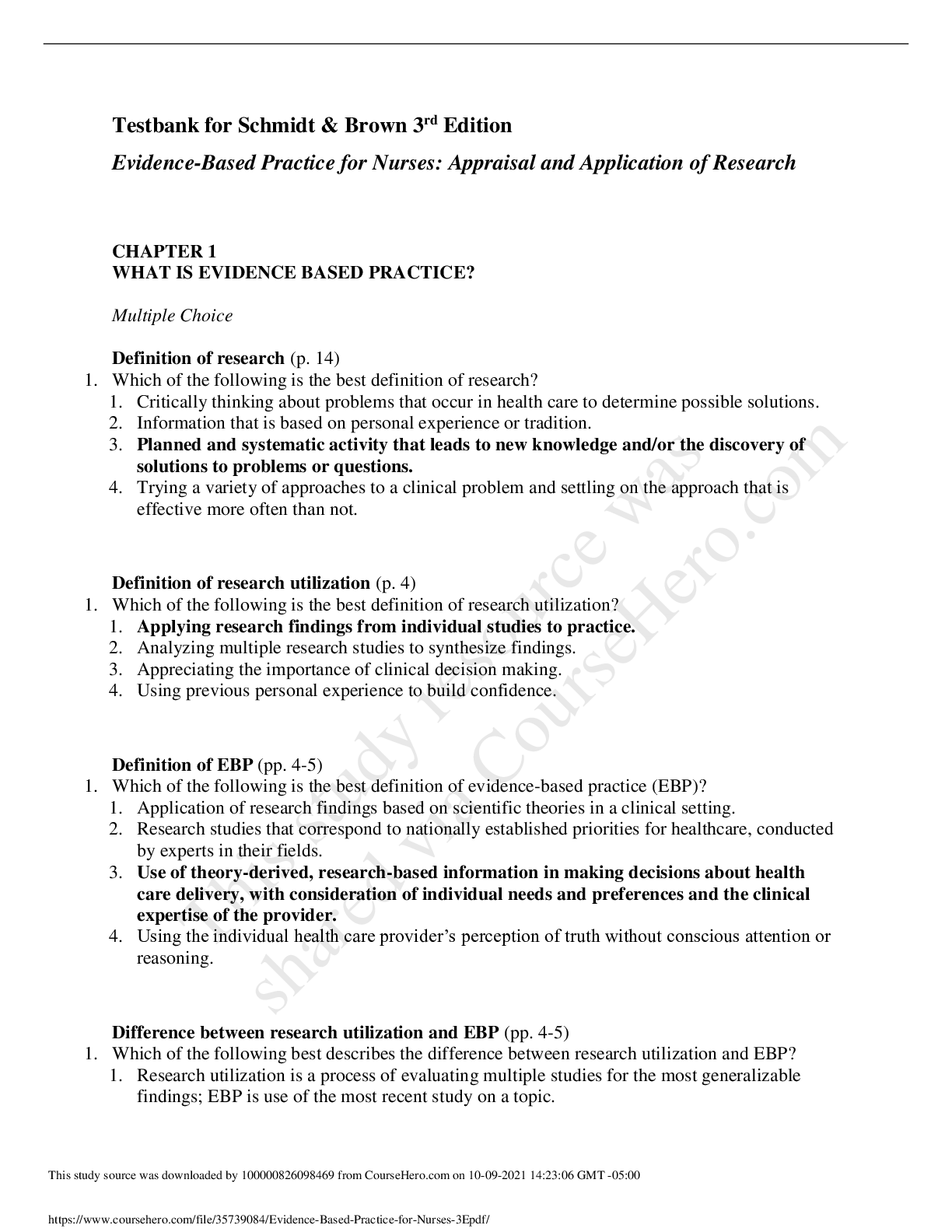
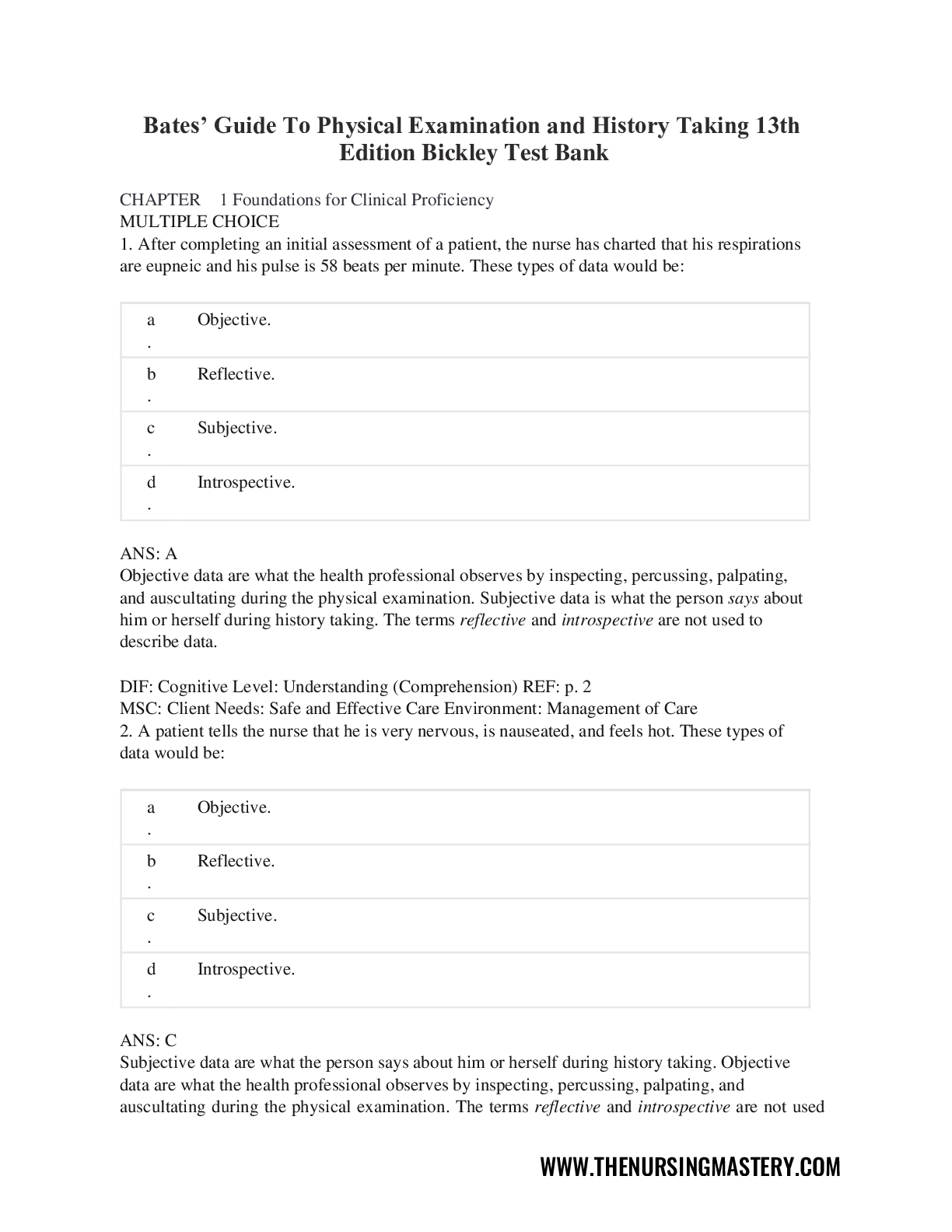
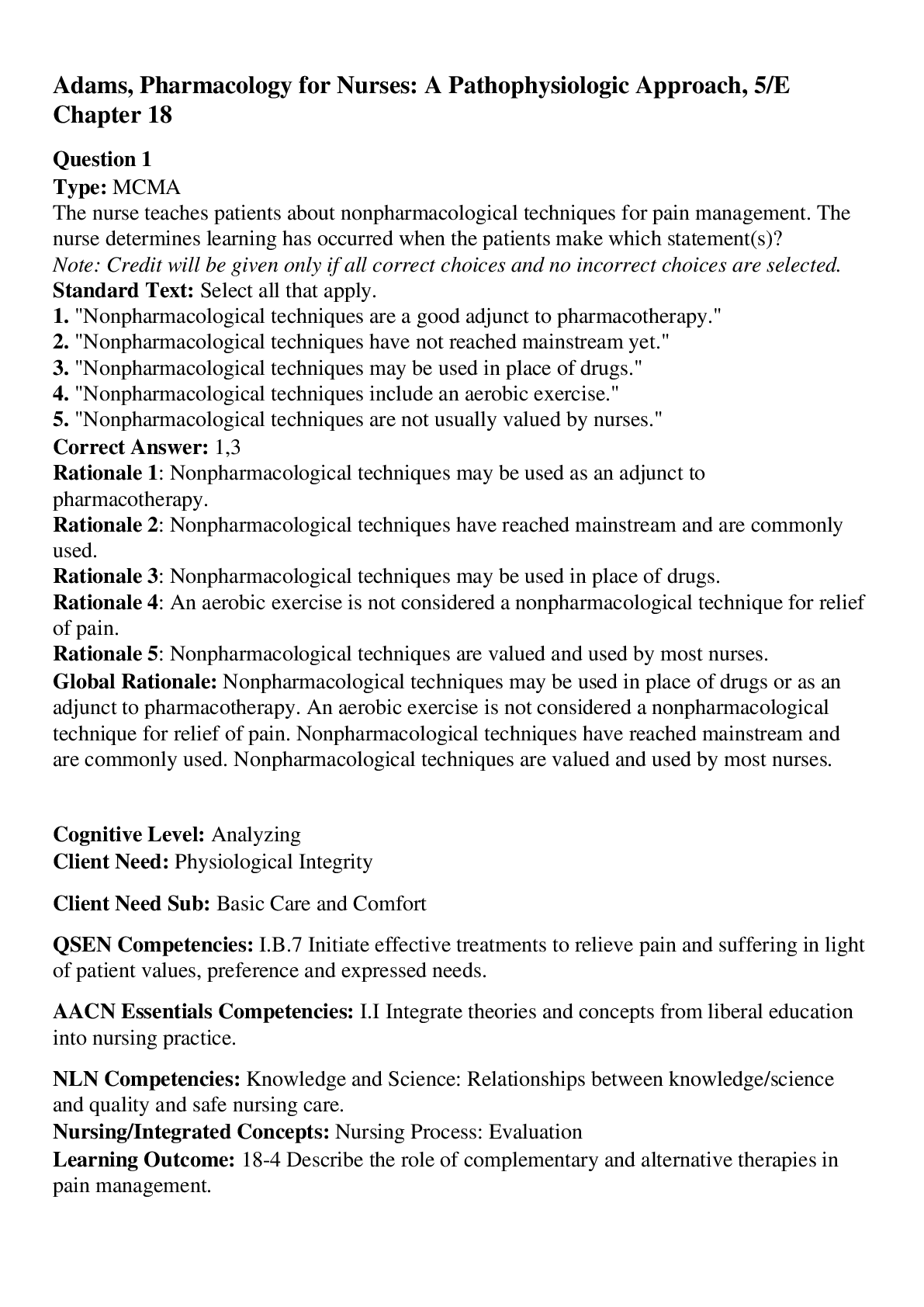
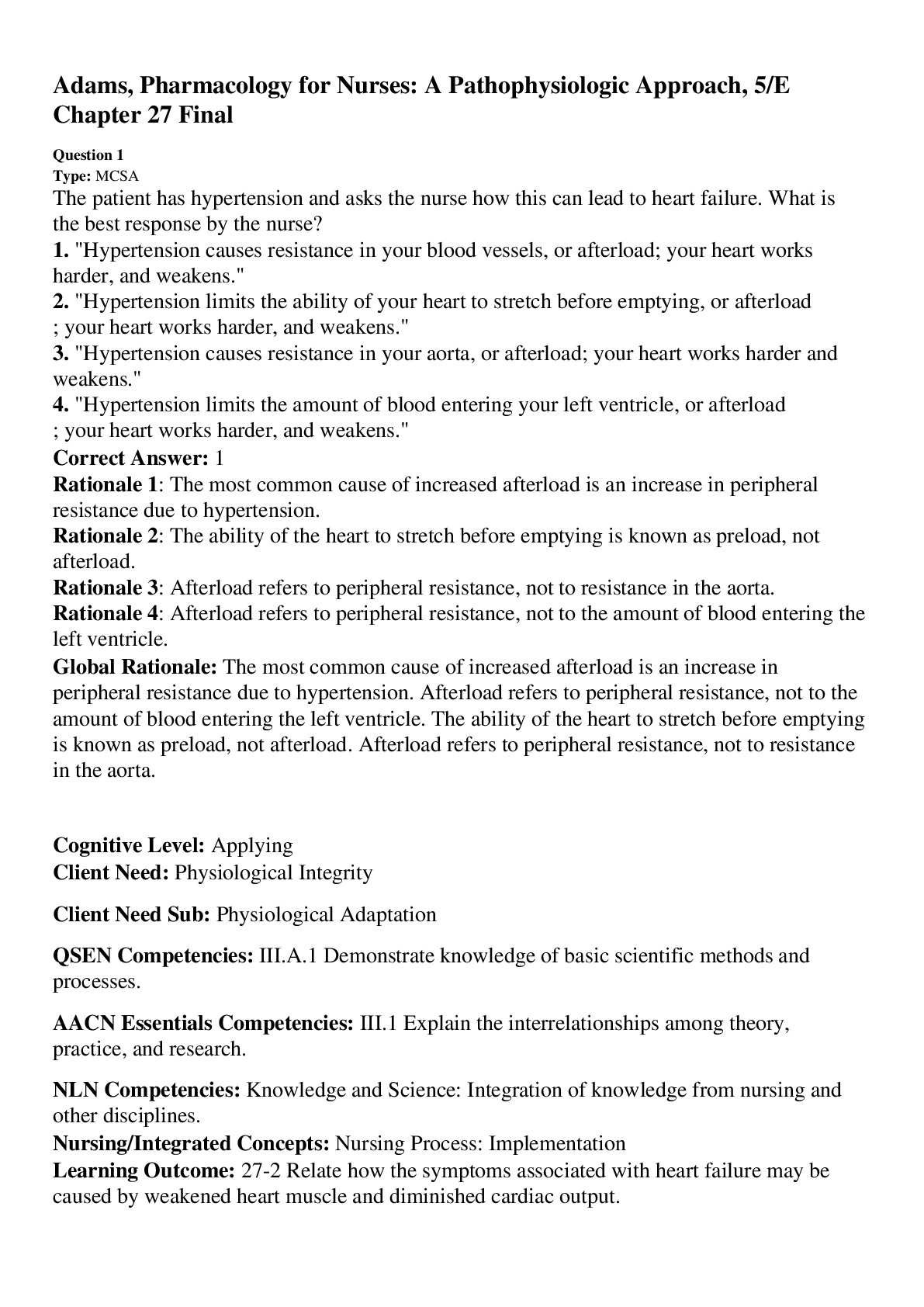

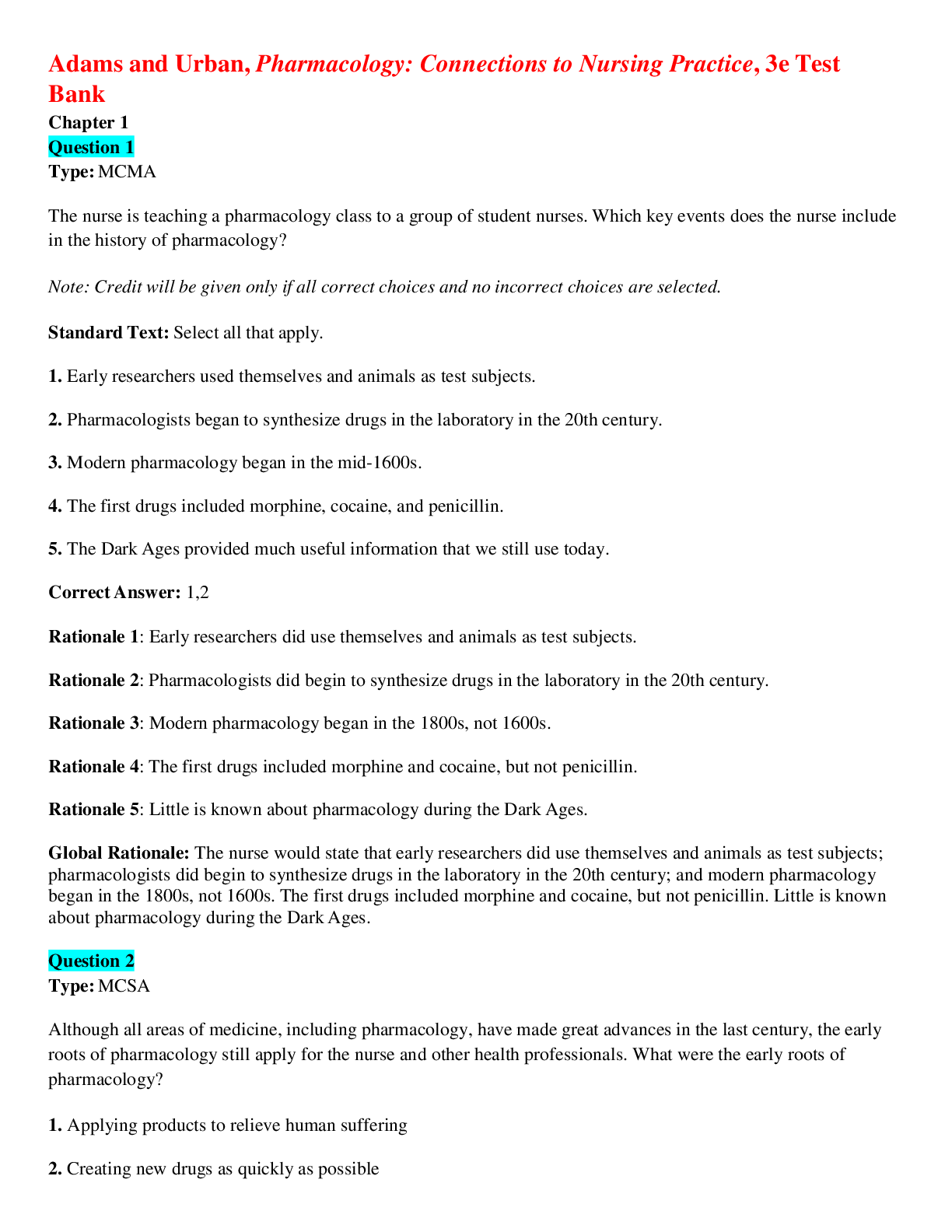


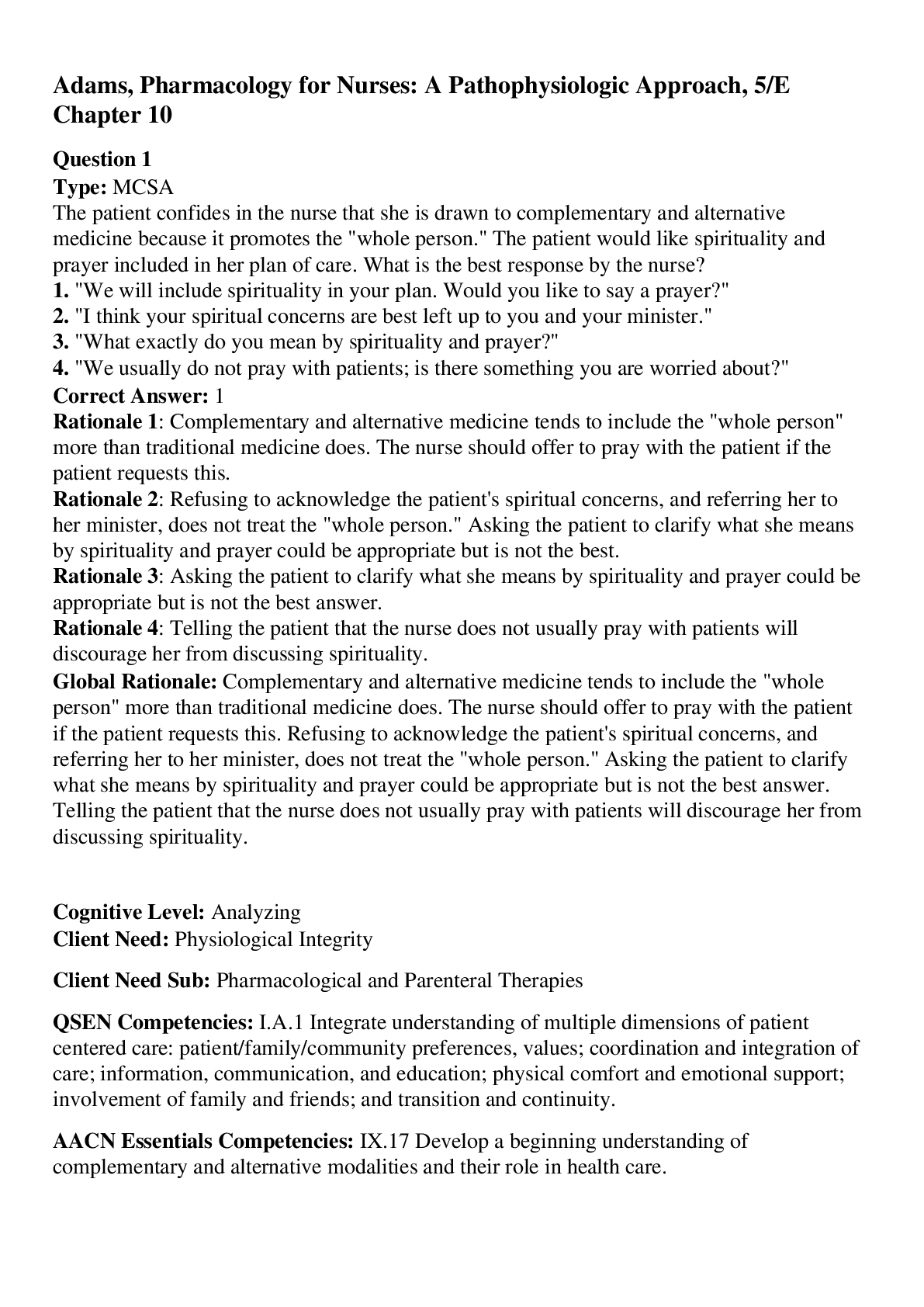
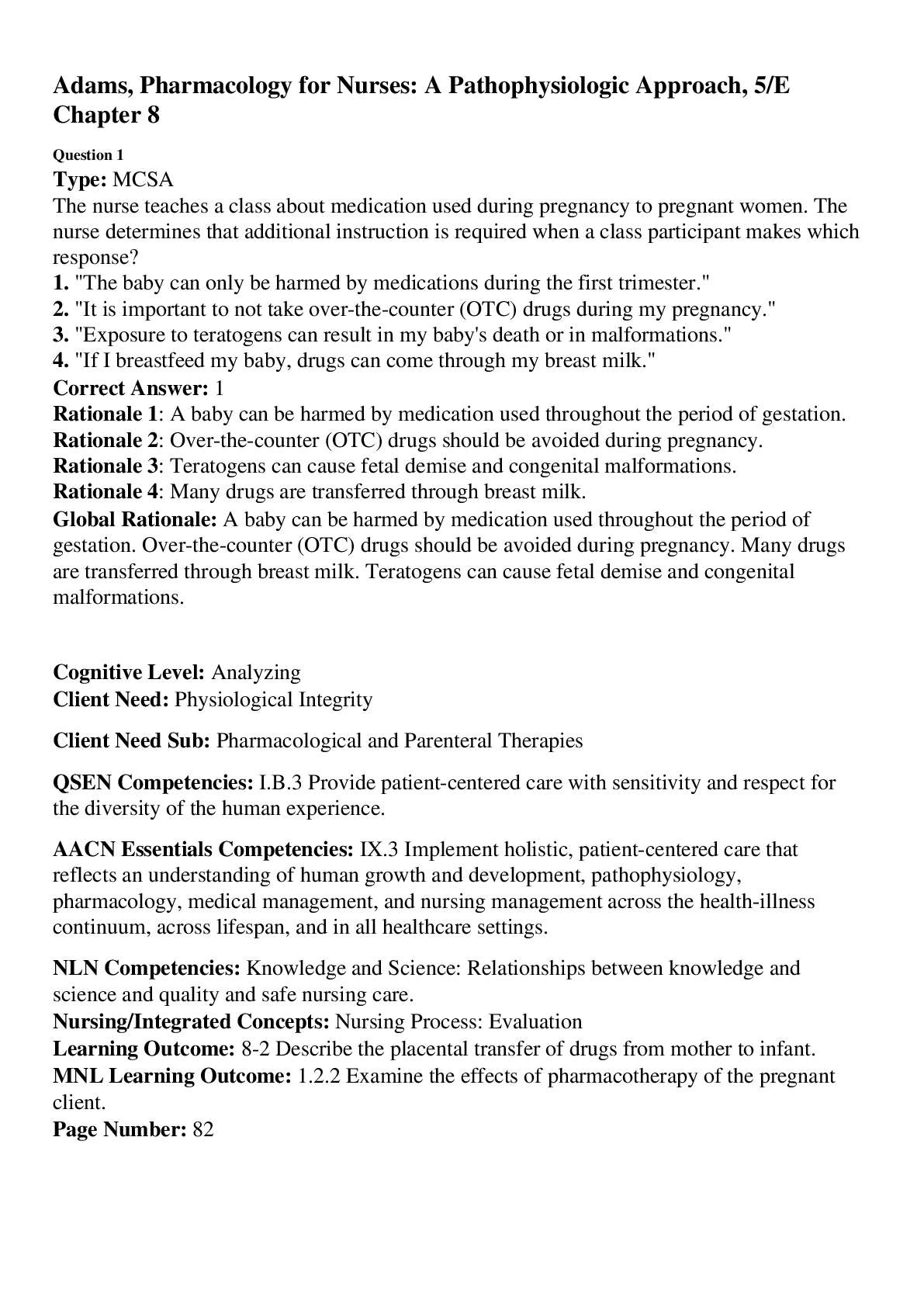
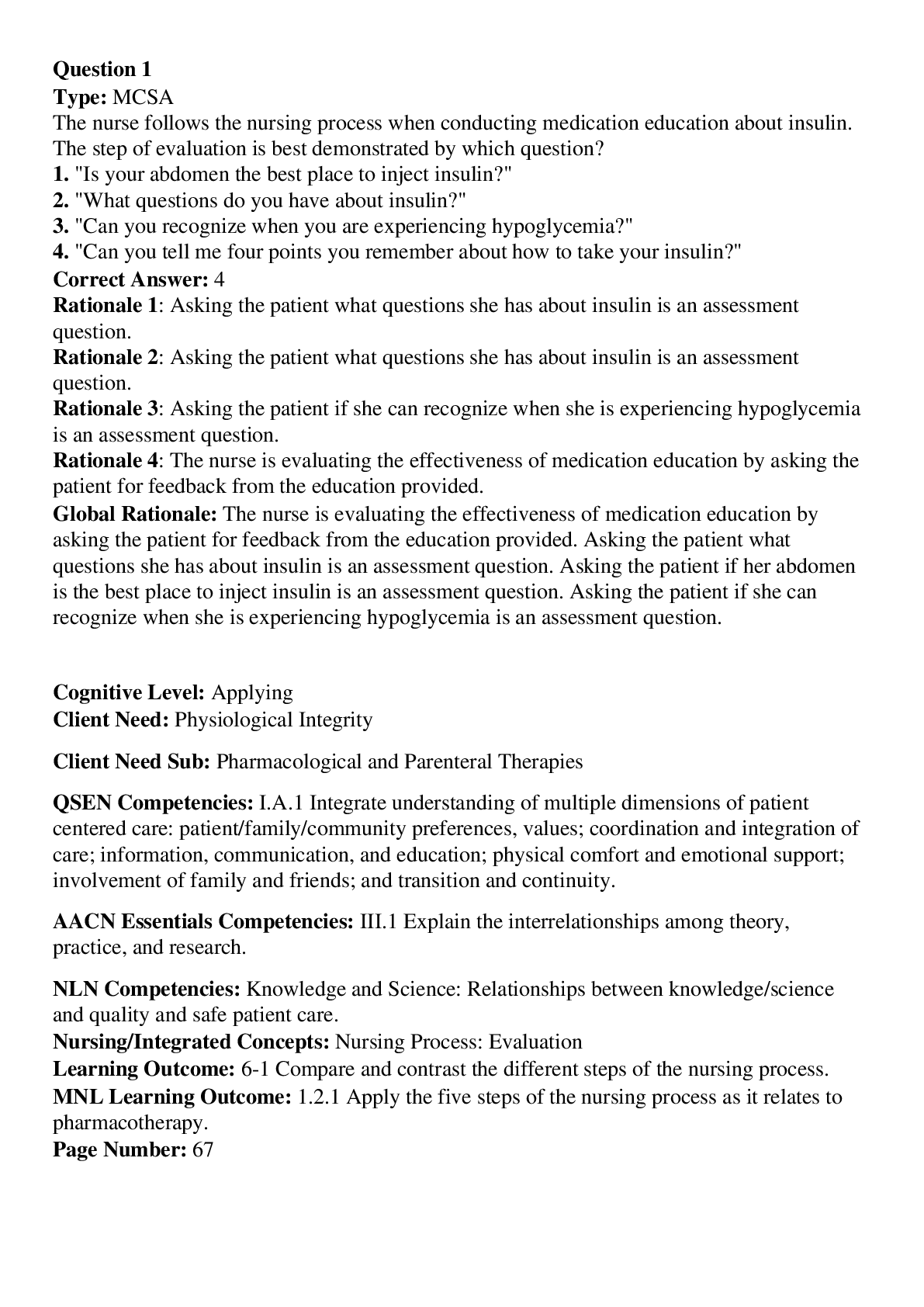
.png)
